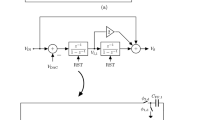Abstract
A low-noise small-area three-stage operational amplifier is presented for arrayed sensor interface systems. The designed amplifier employs a novel small-area phase compensation scheme that allows a relatively high transconductance in the first stage, resulting in relatively low input-referred noise. The proposed amplifier implemented in a standard 180-nm CMOS process occupies an active area of only 0.015 \(\mathrm{mm}^2\). The measurement results show that the amplifier achieves a 6.2-MHz gain-bandwidth product, an input-referred noise of 27 nV/\(\surd \)Hz, and a phase margin of 60°. The current dissipation is 177 \(\upmu \)A at a power supply of 1.5 V.











Similar content being viewed by others
References
Uddin, A., Milaninia, K., Chen, C. H., & Theogarajan, L. (2011). Wafer scale integration of CMOS chips for biomedical applications via self-aligned masking. IEEE Transactions on Components, Packaging and Manufacturing Technology, 1(12), 1996–2004.
Holleman, J., Zhang, F., & Otis, B. (2011). Ultra low-power integrated circuit design for wireless neural interfaces. Berlin: Springer.
Harrison, R. R. (2008). The design of integrated circuits to observe brain activity. Proceedings of the IEEE, 96(7), 1203–1216.
Aziz, J. N., Abdelhalim, K., Shulyzki, R., Genov, R., Bardakjian, B. L., Derchansky, M., et al. (2009). 256-channel neural recording and delta compression microsystem with 3D electrodes. IEEE Journal of Solid-State Circuits, 44(3), 995–1005.
Akita, I., & Ishida, M. (2013). A 0.06 mm\(^2\) 14 nV/\(\surd \)Hz chopper instrumentation amplifier with automatic differential-pair matching. In 2013 IEEE international solid-state circuits conference digest of technical papers (ISSCC) (pp. 178–179). IEEE.
Uranga, A., Navarro, X., & Barniol, N. (2004). Integrated CMOS amplifier for ENG signal recording. IEEE Transactions on Biomedical Engineering, 51(12), 2188–2194.
Annema, A. J., Nauta, B., Van Langevelde, R., & Tuinhout, H. (2005). Analog circuits in ultra-deep-submicron CMOS. IEEE Journal of Solid-State Circuits, 40(1), 132–143.
Dautriche, P. (2011). Analog design trends and challenges in 28 and 20 nm CMOS technology. In 2011 Proceedings of ESSCIRC (ESSCIRC) (pp. 1–4). IEEE.
Vertregt, M. (2006). The analog challenge of nanometer CMOS. In International electron devices meeting, 2006 (IEDM’06) (pp. 1–8). IEEE.
Guo, S., & Lee, H. (2009). Single-capacitor active-feedback compensation for small-capacitive-load three-stage amplifiers. IEEE Transactions on Circuits and Systems II: Express Briefs, 56(10), 758–762.
Yan, Z., Mak, P. I., Law, M. K., & Martins, R. P. (2013). A 0.016-mm\(^2\) 144-μW three-stage amplifier capable of driving 1-to-15 nF capacitive load with \(>\)0.95-MHz GBW. IEEE Journal of Solid-State Circuits, 48(2), 527–540.
Guo, S., & Lee, H. (2011). Dual active-capacitive-feedback compensation for low-power large-capacitive-load three-stage amplifiers. IEEE Journal of Solid-State Circuits, 46(2), 452–464.
Leach, W. M. (1994). Fundamentals of low-noise analog circuit design. Proceedings of the IEEE, 82(10), 1515–1538.
Haibi, H., Akita, I., & Ishida, M. (2013). A 27-n/\(\surd \)Hz 0.015-mm\(^2\) three-stage operational amplifier with split active-feedback compensation. In 2013 IEEE Asian solid-state circuits conference (A-SSCC) (pp. 365–368). IEEE.
Carusone, T. C. et al. (2012). Analog integrated circuit design. Columbia Law Review Association Harvard Law Review Association.
Razavi, B. (2001). Design of analog CMOS integrated circuits. New York: McGraw-Hill.
Enz, C. C., & Temes, G. C. (1996). Circuit techniques for reducing the effects of op-amp imperfections: Autozeroing, correlated double sampling, and chopper stabilization. Proceedings of the IEEE, 84(11), 1584–1614.
Palumbo, G., & Pennisi, S. (2002). Design methodology and advances in nested-Miller compensation. IEEE Transactions on Circuits and Systems I: Fundamental Theory and Applications, 49(7), 893–903.
Akita, I., & Ishida, M. (2014). A chopper-stabilized instrumentation amplifier using area-efficient self-trimming technique. Analog Integrated Circuits and Signal Processing, 81(3), 571–582.
Steyaert, M. S., & Sansen, W. M. (1987). A micropower low-noise monolithic instrumentation amplifier for medical purposes. IEEE Journal of Solid-State Circuits, 22(6), 1163–1168.
Acknowledgements
This work was supported in part by JSPS Grant-in-Aid for Scientific Research (15H05525 and 25820141). We would like to express our thanks to Rohm Corp., Toppan Printing Corp., and Cadence Design Systems Inc. and Mentor Graphics Inc. through the VLSI Design and Education Center (VDEC), the University of Tokyo, for chip fabrication and EDA tools.
Author information
Authors and Affiliations
Corresponding author
Rights and permissions
About this article
Cite this article
Akita, I., Haibi, H. & Ishida, M. A low-noise small-area operational amplifier using split active-feedback compensation technique. Analog Integr Circ Sig Process 96, 555–564 (2018). https://doi.org/10.1007/s10470-018-1184-7
Received:
Revised:
Accepted:
Published:
Issue Date:
DOI: https://doi.org/10.1007/s10470-018-1184-7




